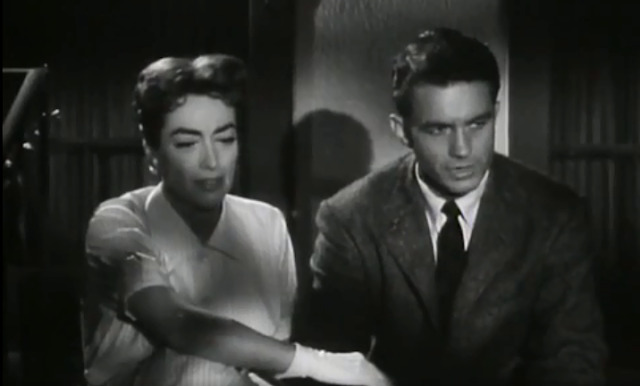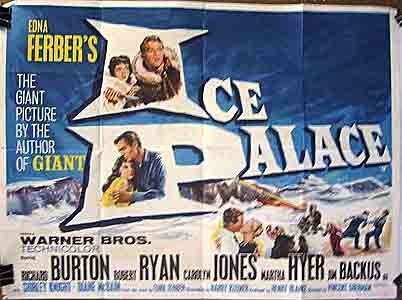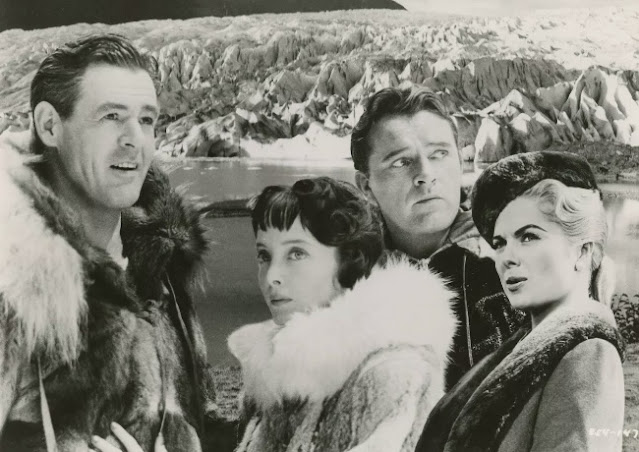 |
| A young Cliff Robertson and mature Joan Crawford have a believable chemistry in the May-September romance, "Autumn Leaves." |
Autumn
Leaves offered a rare sympathetic role for Joan Crawford in the 1950s,
the autumn of the great star’s career. This was also Crawford’s first
collaboration with director Robert Aldrich, usually known for his tough take in
storytelling. In this adult soap opera, their team work is subtle and
sympathetic.
 |
| Joan Crawford's Milly is a typist and you better believe she's the best! |
Crawford plays Milly Wetherby, a work at home
typist, who meets a younger man on a rare evening out. Burt Hanson, played by
film newcomer Cliff Robertson, is a returning veteran. They strike up a
friendship, which leads to romance. Initially resistant because of their age
difference, Milly comes to realize that she really loves Burt. They marry and
the honeymoon period is idyllic. Reality intrudes when Burt’s past catches up
to him in the form of an ex-wife and estranged father. The young man’s stories
don’t add up, and his family’s version doesn’t speak well for him. And their
claim that he is unstable is indisputable, as Burt begins to fall apart. Still,
there is more than meets the eye, as Milly is determined to not only help Burt,
but get to the truth of the matter.
 |
| Crawford's Milly eventually realizes that she's ready to take a chance on love with Robertson's Burt Hanson in "Autumn Leaves." |
Kudos goes to both
director Aldrich and star Crawford. They
were known to go over the top and both the film’s direction and lead
performance are surprisingly restrained and effective. Yes, there are moments
when Robertson's troubled young man’s downfall is a bit voyeuristic. But
Aldrich is empathetic to character Burt Hanson’s plight and makes him neither a
weakling nor a bad guy. The director gives this "woman's picture" a noir-ish
take, with camera work that heightens the tension. Best of all, Aldrich's look
at the May-December romance between the typist and the tie salesman is treated
seriously.
 |
| Burt Hanson's mental illness is handled sensitively in "Autumn Leaves," without sentimentality or sensationalism. |
As for Joan Crawford,
she rarely got to play a sympathetic character so warmly in the '50s—an era of
tough cookies, control freaks, or flat-out neurotic bitches: The Damned Don't Cry; Harriet Craig; This Woman is Dangerous; Torch
Song; Johnny Guitar; Queen Bee; Female on the Beach; and The
Best of Everything.
 |
| Joan Crawford's Milly, having a night on the town, in "Autumn Leaves." |
Joan's spinster typist
Milly Wetherby is practical, confident, yet warm and caring; Crawford’s scenes
depicting her loneliness certainly resonate. When Millie finally takes a chance
on love, she gives her all, and you care for Crawford’s character. Along with Baby Jane, this is Joan's best latter
day role and performance. Except for a few trademark Crawford poses in some of
the big scenes, Joan is at her most genuine and straightforward here.
 |
| At nearly 50, Joan was in fine form in "Autumn Leaves," here with co-star Cliff Robertson and director Robert Aldrich. |
The only criticism I
have is that it's a shame someone couldn't get Joan to tone down her visual
style in Autumn Leaves. At nearly 50,
a swimsuit scene shows Joan in fine form and her huge eyes and bone
structure were eternal. While the infamous Crawford shadows are ever-present,
along with some heavy duty makeup contouring from the jaw line down, this was pretty
typical of the era. But Joan's makeup of her eyes, eyebrows, and lips are truly
startling, especially when she's in scenes with younger cast members, who are made
up to look like merely attractive mortals. Joan’s severe cropped hair was unfortunate
for most of her '50s.This called more attention to her age, along with some ill-advised
extreme close-ups.
 |
| Not sure who thought extreme close-ups like these of Joan Crawford were a good idea. |
As Burt Hanson, this
was Cliff Robertson's first leading man role. Robertson would play another
mentally challenged man a dozen years later, as Charly, for which Cliff won an Oscar. Robertson uses his boyish charm
to an almost Jimmy Stewart-like degree. He's very winning and it’s startling
when he turns on a dime into a rage. When his character is hauled away, Burt
has a male Blanche DuBois moment.
 |
| Robertson's Burt depends on the kindness of strangers and Crawford's Milly in "Autumn Leaves." |
The 1956 film featured
a great supporting cast, with Vera Miles looking every inch the Hitchcock
blonde as the scheming ex-wife. This year was a break out for Miles as well as Cliff
Robertson. Along with this showy role, Miles worked with John Ford in The Searchers and Alfred Hitchcock for
the first time in The Wrong Man. Smoothly
villainous Lorne Greene is memorable as Burt’s father, before he became saintly
patriarch Ben Cartwright three years later. Ruth Donnelly is a scene stealer as
outspoken but big-hearted Liz, Milly’s apartment complex manager. Also, future Baby Jane cast member Marjorie Bennett
has a great bit as the waitress with an attitude.
 |
| A striking shot of Burt's loving family, as played by Lorne Greene and Vera Miles. |
There's a number of
lovely scenes in Autumn Leaves: the
banter between landlady Liz and Joan's work-at-home typist; lonely Joan
determined to have a nice night out solo; the first meeting of Burt and Milly
at the restaurant; their courtship and the navigation of trust into love; the
scenes where Milly battles Burt's selfish father and ex-wife that give Joan a
chance to breathe some fire; the breakdown scenes, which are realistic; and the
ending is hopeful, but not corny.
 |
| The two Mrs. Hansons: Joan Crawford as the current Mrs.; Vera Miles is the ex! |
For a ‘50s film soap
opera, Autumn Leaves feels authentic.
It’s a Crawford fan favorite, and even those who aren’t one of Joan’s fans may
be pleasantly surprised.
 |
| "Autumn Leaves" seems to be copying the love scene from another Columbia film, "From Here to Eternity." Legend has it that Joan Crawford turned the Deborah Kerr role down! |
Also, here’s my look at Joan’s signature role, Mildred Pierce: https://ricksrealreel.blogspot.com/2020/03/how-joan-crawford-became-mildred-pierce.html
 |
| Milly gets her happy ending, though warned Burt might have changed once cured, at the finale of "Autumn Leaves." |











.jpg)
